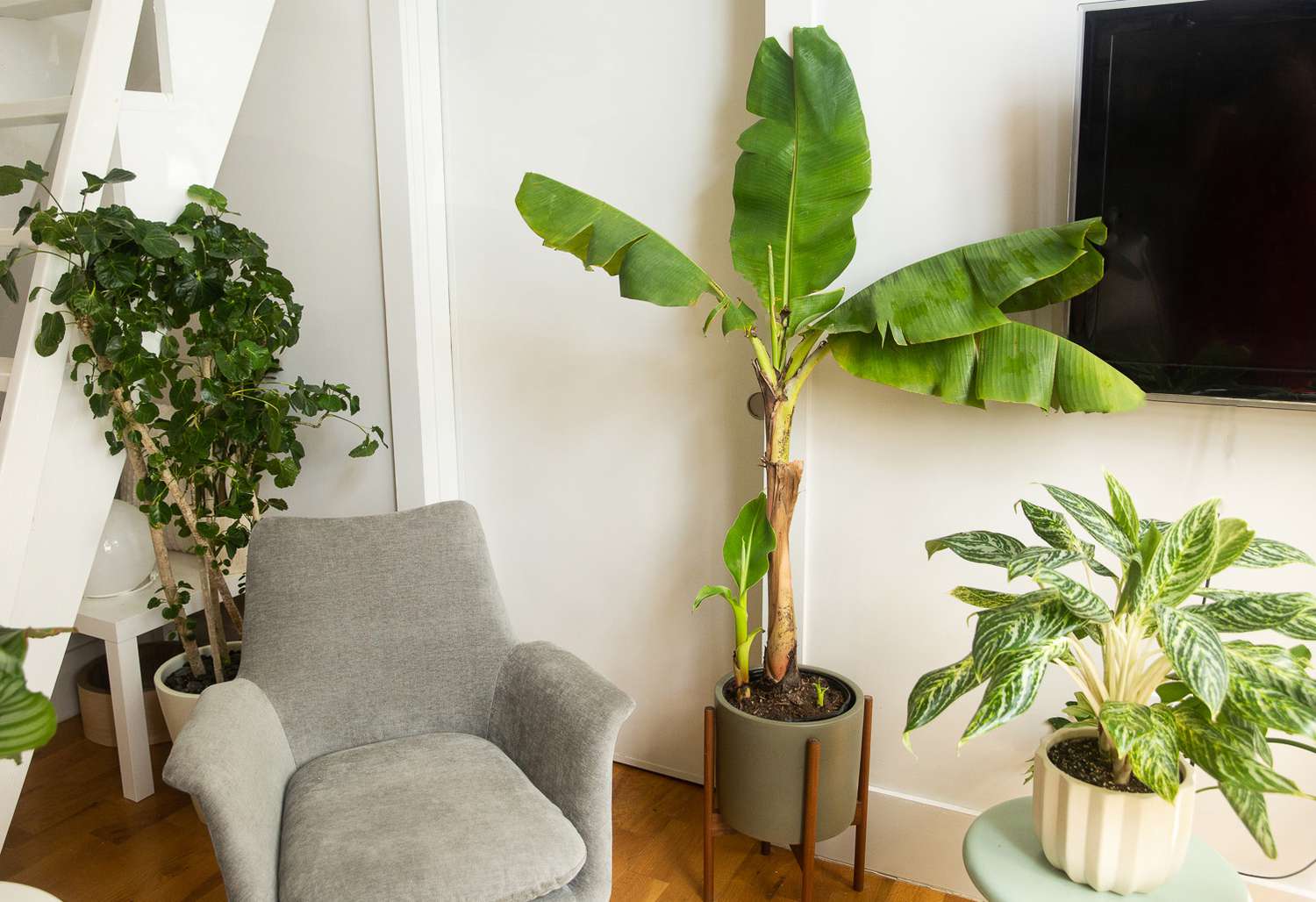Banana Tree Care: What You Need to Know
Banana trees, with their lush green leaves and iconic fruit, are beloved by many gardeners and plant enthusiasts. Whether you’re drawn to them for their tropical aesthetic, their delicious fruit, or their cultural significance, banana trees have a special place in the world of plants.
This comprehensive guide is designed to help you understand the intricacies of caring for banana trees, whether you’re growing them for their ornamental beauty or their delectable harvest.
Banana trees have captured the hearts of gardeners and plant lovers for various reasons:
- Exotic Aesthetics: With their large, vibrant leaves and a look reminiscent of tropical paradise, banana trees add a touch of the exotic to any garden or indoor space.
- Versatile Uses: While many people grow banana trees for their delicious fruit, they are also cherished as ornamental plants, adding a sense of lushness and luxury to landscapes.
- Cultural Significance: Bananas hold cultural importance in many parts of the world. They feature in rituals, celebrations, and traditional dishes, making them more than just a garden plant.
Types of Banana Trees
Banana trees come in a wide array of varieties, each with its unique characteristics. Understanding the different types can help you choose the right one for your needs. Some common varieties include:
- Dessert Bananas (Musa acuminata): These are the classic sweet bananas found in grocery stores. Varieties include Cavendish, Lady Finger, and Williams.
- Plantains (Musa paradisiaca): Plantains are starchy cooking bananas often used in savory dishes. They are a staple in many tropical cuisines.
- Ornamental Bananas: These banana trees are primarily grown for their striking appearance, with bold foliage and unique shapes. The Blood Banana (Musa zebrina) and the Abyssinian Banana (Ensete ventricosum) are popular ornamental varieties.
Characteristics and Uses of Ornamental vs. Fruit-Producing Banana Trees
- Ornamental Banana Trees: These varieties are prized for their striking foliage and aesthetic appeal. While some may produce small, inedible fruit, their primary purpose is to enhance the visual appeal of gardens and indoor spaces.
Read Also: Man-Environment Interaction (Environmentalism, Possibilism, and Probabilism)
- Fruit-Producing Banana Trees: These varieties yield delicious and nutritious fruit. They can be cultivated for both personal consumption and as a source of income. The taste, size, and texture of the fruit may vary among different types.
Soil and Fertilization for Banana Trees
The right soil is essential for the health and productivity of banana trees. Here’s what you need to know about their soil requirements:
- Well-Draining Soil: Banana trees prefer well-draining soil to prevent waterlogged roots, which can lead to rot. A loamy soil mix with good drainage properties is ideal.
- Organic Matter: Adding organic matter, such as compost, to the soil improves fertility and moisture retention. This is especially important in sandy or clayey soils.
- pH Level: Banana trees thrive in slightly acidic to neutral soil with a pH range between 6 and 7.
Fertilization and Nutrient Needs for Healthy Growth
To ensure robust growth and a bountiful harvest, you’ll need to provide the right nutrients for your banana trees:
- Nitrogen: Bananas are nitrogen-hungry plants. Fertilize regularly with a balanced, slow-release fertilizer to meet their nitrogen requirements. However, avoid over-fertilization, which can lead to lush foliage at the expense of fruit production.
- Potassium: Potassium is crucial for fruit development and overall plant health. Choose a fertilizer with a higher potassium content (the third number in the NPK ratio) to promote fruiting.
- Micronutrients: Banana trees benefit from micronutrients like magnesium and boron. Consider occasional foliar applications of a micronutrient solution if you notice deficiencies in the leaves.
- Organic Matter: Incorporating organic matter into the soil not only improves its structure but also provides a steady source of nutrients as it breaks down.
- Mulch: Apply a layer of organic mulch around the base of the tree to help conserve soil moisture and gradually release nutrients as it decomposes.
Watering Practices For Banana Trees
Proper watering is critical for banana tree care. Follow these guidelines to establish a suitable watering routine:
- Consistent Moisture: Keep the soil consistently moist but not waterlogged. Water deeply and thoroughly, ensuring that the root zone receives adequate moisture.
- Frequency: The frequency of watering depends on factors like temperature, humidity, and soil type. During hot and dry periods, you may need to water more often.
- Rainwater: Whenever possible, use rainwater for irrigation. It’s free of the salts and chemicals found in tap water, which can accumulate in the soil over time.
- Drip Irrigation: Drip irrigation systems can provide efficient and consistent watering for banana trees.
Recognizing Signs of Overwatering and Underwatering
Understanding the signs of overwatering and underwatering is crucial to maintaining the health of your banana trees:
- Overwatering: Signs of overwatering include wilting leaves, yellowing or browning of lower leaves, and a foul odor emanating from the soil. If you notice these symptoms, reduce watering and improve drainage.
- Underwatering: Underwatered banana trees exhibit drooping or shriveling leaves, reduced fruit production, and slow growth. Increase watering frequency during dry spells.
By providing the right soil conditions and nutrient balance, along with a well-managed watering routine, you can help your banana trees flourish and yield an abundant crop of delicious fruit.
Pruning and Maintenance For Banana Trees
Pruning is an essential aspect of banana tree care. Proper pruning can help manage the size of the plant and maintain its health:
- Remove Dead or Damaged Leaves: Regularly trim dead or damaged leaves to prevent disease and pests from taking hold.
- Thinning: To encourage healthy air circulation and light penetration, thin out crowded leaves. This also aids in fruit development and reduces the risk of fungal infections.
- Pest Control: Prune away and dispose of any affected or infested plant parts to control pest problems.
Dealing with Common Issues like Pests and Diseases
- Pest Management: Keep an eye out for common banana tree pests, including aphids, mealybugs, and scales. If you spot an infestation, treat the affected areas with neem oil or insecticidal soap.
- Fungal Diseases: Bananas are susceptible to fungal diseases like Panama disease and Sigatoka leaf spot. To prevent these issues, maintain good air circulation and avoid overwatering.
- Root Rot: Ensure proper drainage to prevent root rot, a common issue in waterlogged soil. If you suspect root rot, trim away affected roots and treat the plant with a fungicide.
Proactive pruning and vigilance against pests and diseases are essential components of banana tree maintenance. By maintaining a healthy growing environment and addressing issues promptly, you can enjoy a thriving banana tree that produces an abundance of delectable fruit.
Flowering and Fruit Production For Banana Trees
The banana tree’s flowering process is a fascinating journey. Here’s a brief overview:
- Inflorescence: Bananas produce an inflorescence, which is a large, drooping structure composed of layers of bracts. Each bract contains clusters of flowers.
- Female and Male Flowers: The first rows of flowers are female, while the later rows are male. The female flowers develop into fruit, and the male flowers produce pollen.
- Pollination: Most banana varieties are sterile and don’t require pollination by insects or wind. Instead, they produce fruit through parthenocarpy, where fruit forms without fertilization.
- Fruit Development: After pollination (in some varieties) or without it, the female flowers develop into clusters of bananas. As they grow, the bracts protect the developing fruit.
Tips for Encouraging Fruit Production
To encourage fruit production in your banana trees, consider the following tips:
- Fertilization: Use a potassium-rich fertilizer, which promotes flowering and fruiting. Apply it regularly during the growing season.
- Pruning: Prune away excess shoots or pups to redirect energy towards fruit production. This helps ensure that the plant’s resources are concentrated on developing fruit.
- Support: Provide support for heavy fruit bunches. This prevents the plant from toppling over and protects the developing fruit.
- Mulching: Apply a layer of organic mulch around the base of the tree to conserve soil moisture and maintain even soil temperatures.
Harvesting and Enjoying Bananas
Bananas are best enjoyed when they’re at the right stage of ripeness. Here’s how to know when to harvest:
- Color Change: Most bananas are harvested when they have turned from green to yellow. The specific hue varies with the variety, but the fruit should be fully yellow and not green.
- Firmness: The fruit should yield slightly to gentle pressure when touched, indicating that it’s ripe. However, it should not be overly soft or mushy.
- Tool or Twist: Use a sharp knife or scissors to cut the banana bunch from the tree. Alternatively, you can twist the bunch gently to separate it from the stem.
Storing and Using the Fruit
To store and use bananas effectively, follow these guidelines:
- Storage: Store ripe bananas at room temperature, away from direct sunlight. If you need to extend their shelf life, place them in the refrigerator. Overripe bananas can be frozen for later use in smoothies or baking.
- Culinary Uses: Bananas are versatile and can be enjoyed fresh, added to cereal or yogurt, or used in smoothies. They’re also great for baking in muffins, bread, and desserts.
- Peeling: To peel a banana, simply grasp the stem and gently pull it downward. The peel should come off easily, revealing the delicious fruit inside.
- Nutritional Value: Bananas are a nutritious snack, rich in potassium, fiber, and essential vitamins. They provide quick energy and are a healthy addition to your diet.
Propagation of Banana Trees
Propagating new banana trees allows you to expand your plantation or share plants with others. Here are common propagation methods:
- Offshoots or Pups: Most banana plants produce offshoots, or “pups,” from their base. These can be carefully separated and replanted to grow new trees.
- Rhizome Division: Some varieties can be propagated by dividing the rhizomes, which are underground stems. Each division should have a portion of the rhizome with roots attached.
- Tissue Culture: This is a more advanced method where small sections of the plant’s tissue are cultured in a sterile environment to produce new plants. It’s commonly used in commercial banana production.
- Seeds: Growing bananas from seeds is possible, but it’s less common because most cultivated varieties are sterile and produce fruit without seeds.
Propagation allows you to maintain a continuous supply of banana trees, whether for personal enjoyment or agricultural purposes. By selecting the right method for your needs and following proper techniques, you can successfully propagate banana trees and nurture them to maturity.
Read Also: 5 Categories of Listeners and Barriers to Effective Listening




